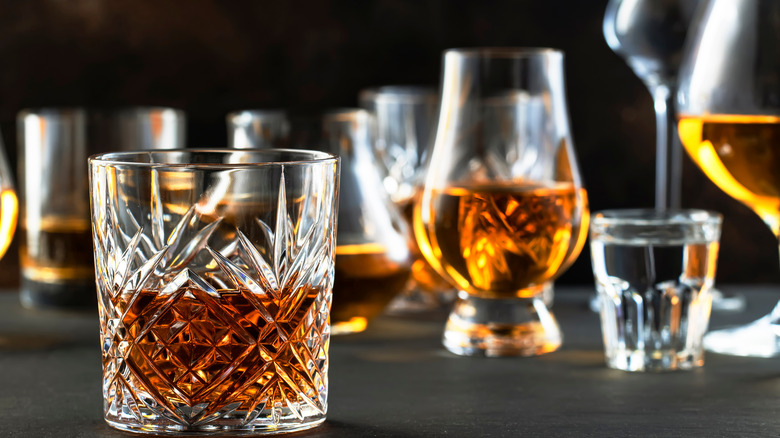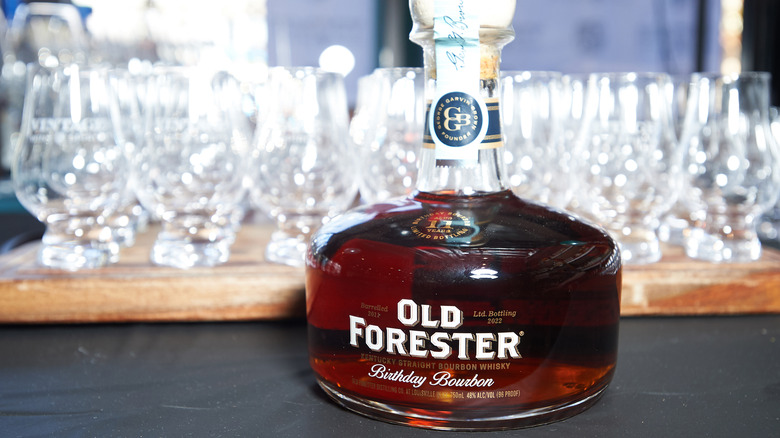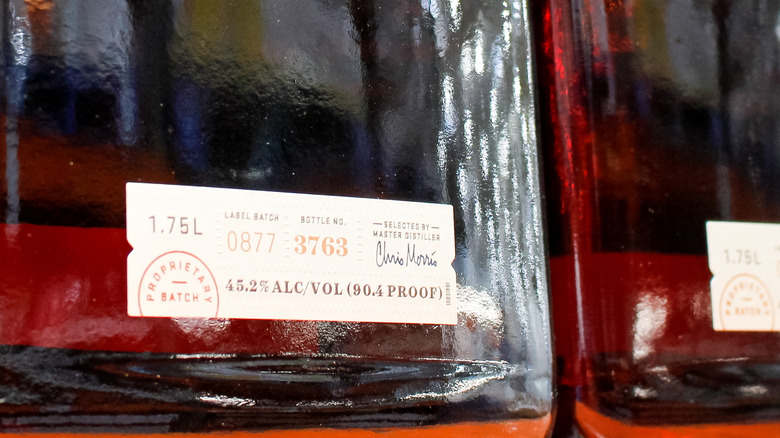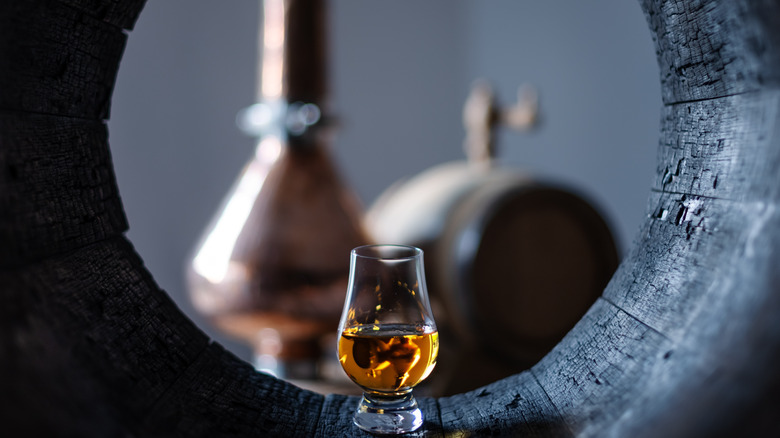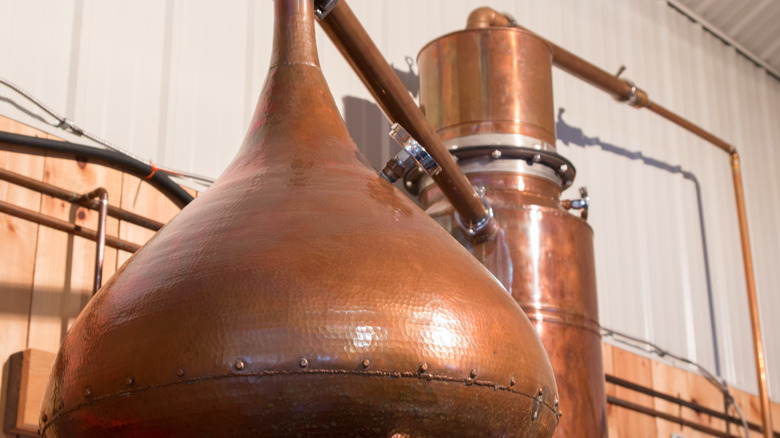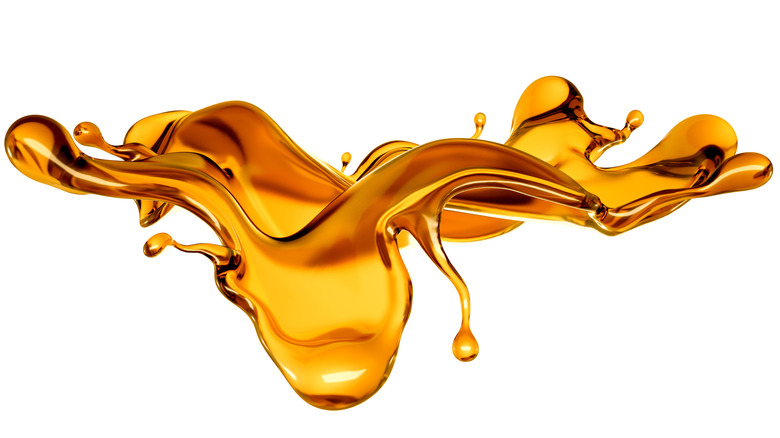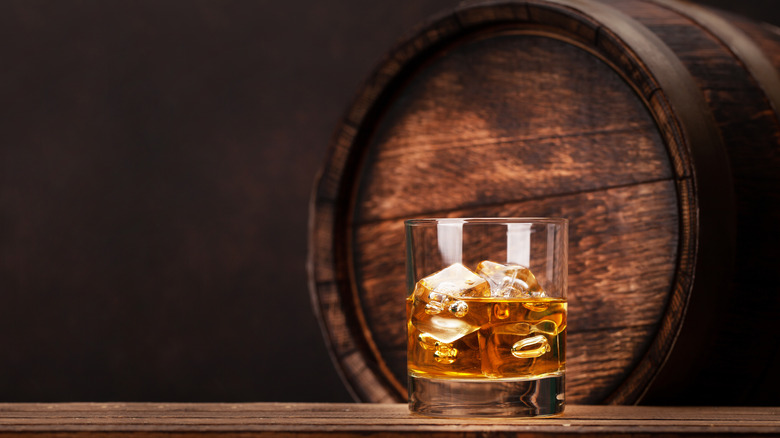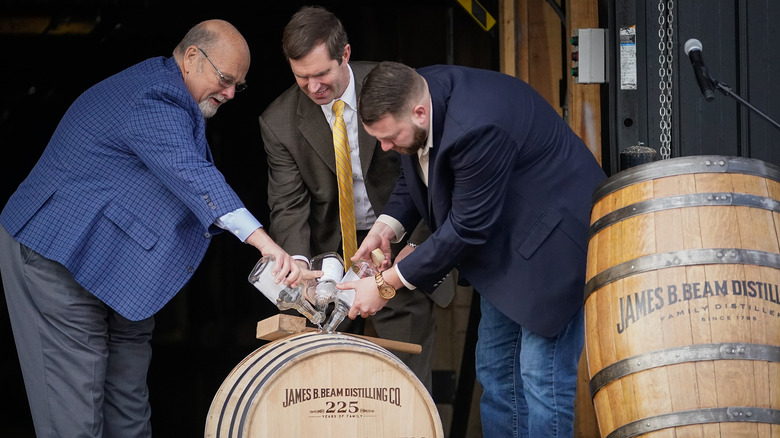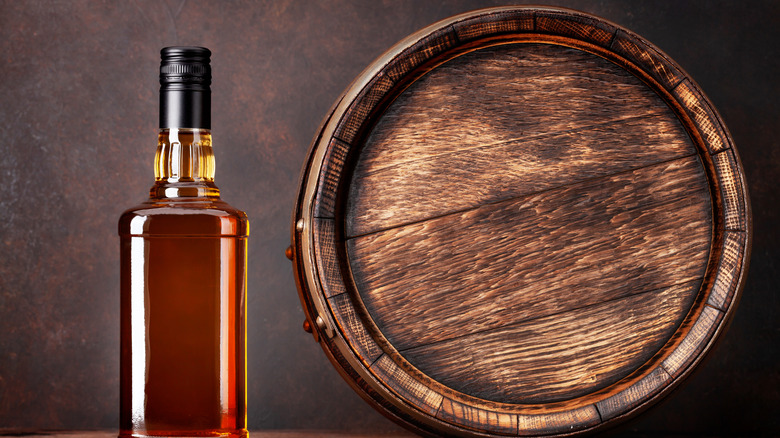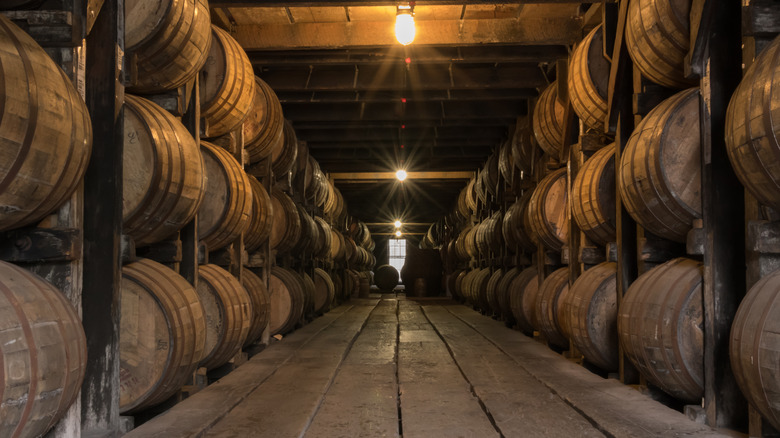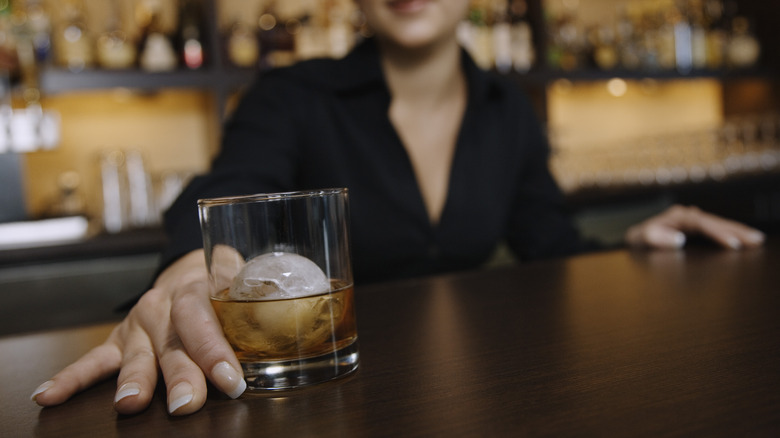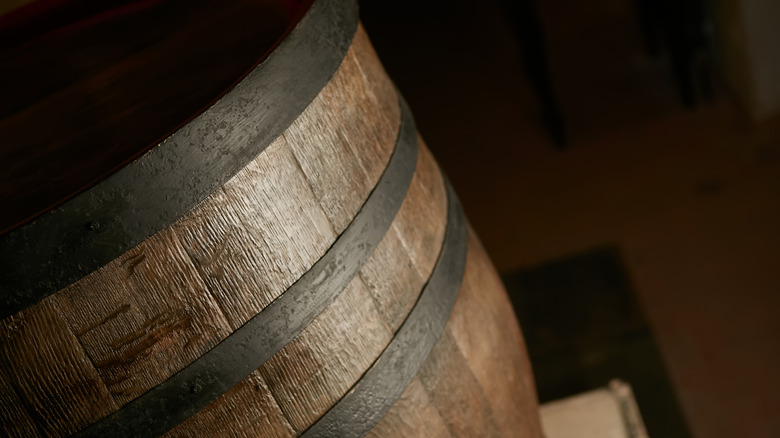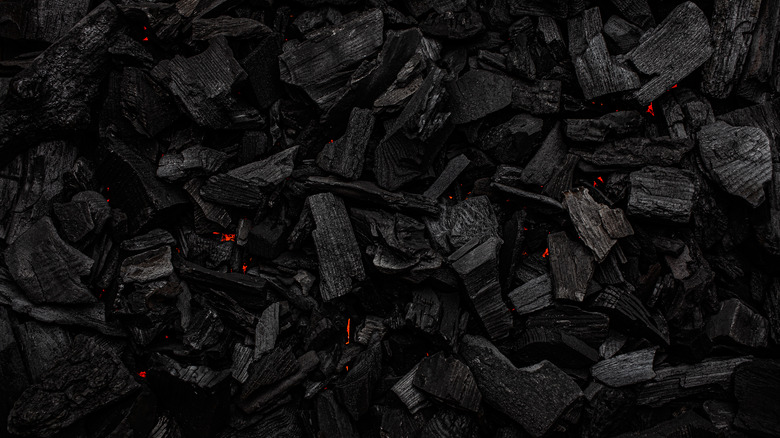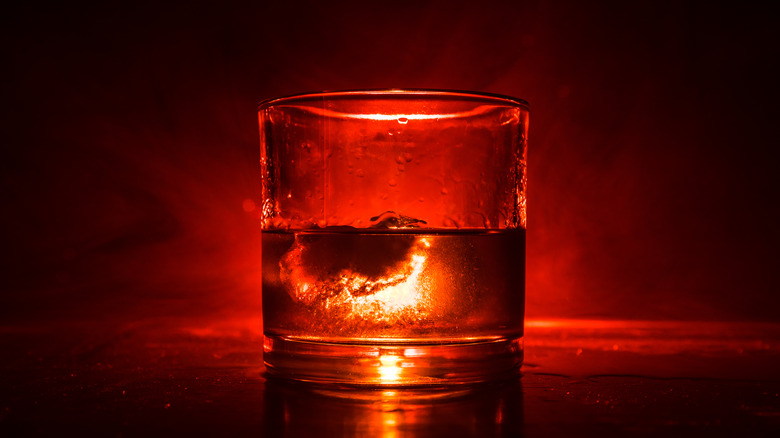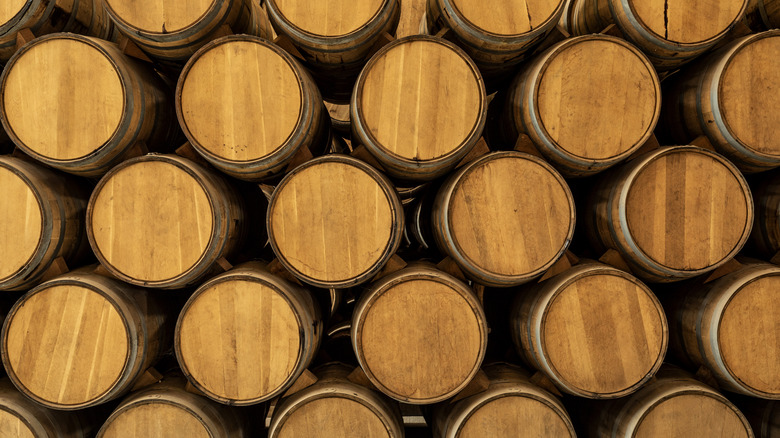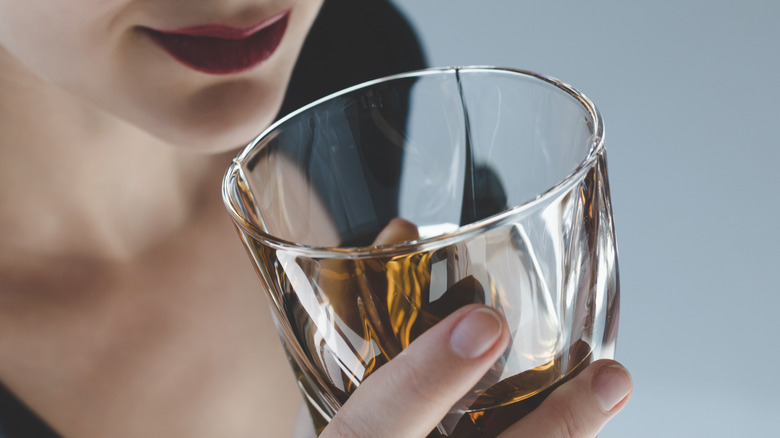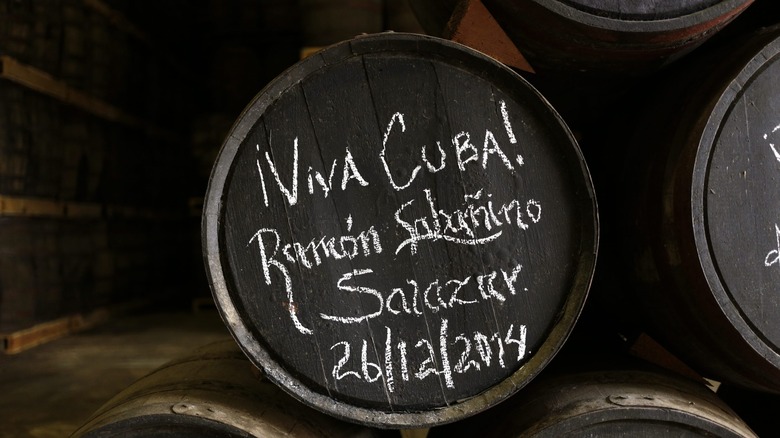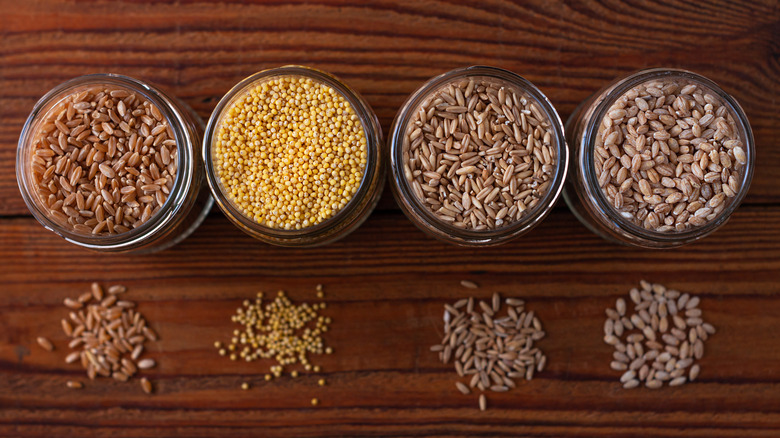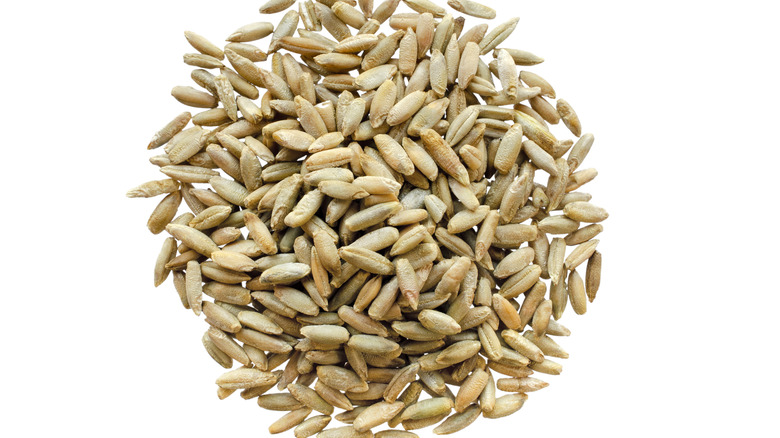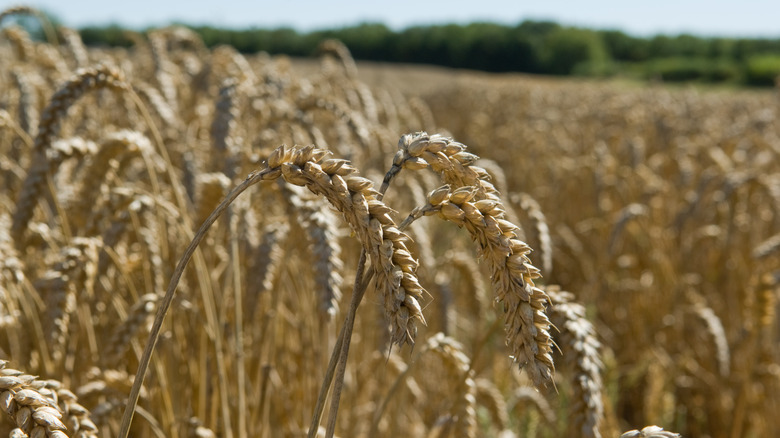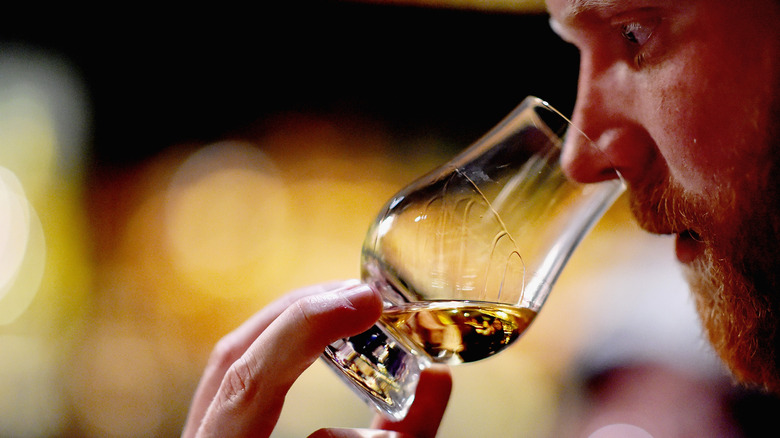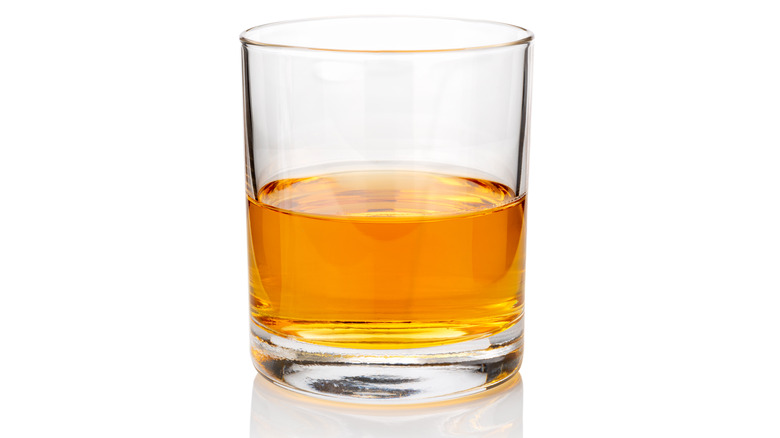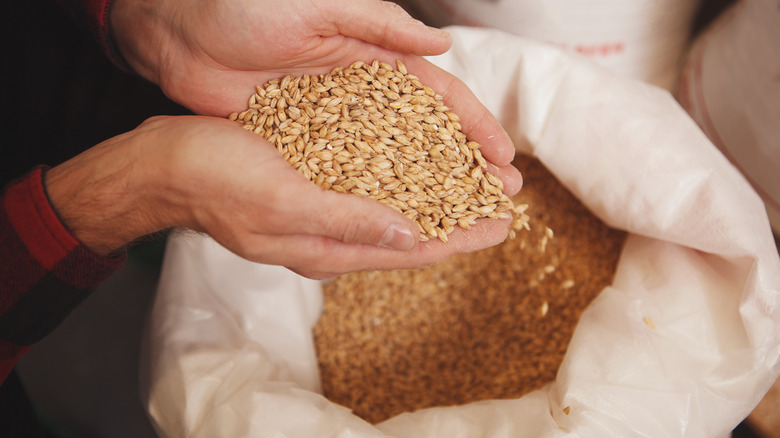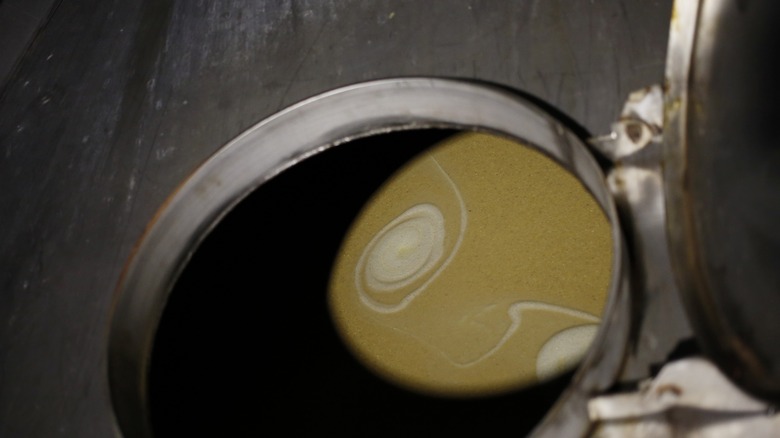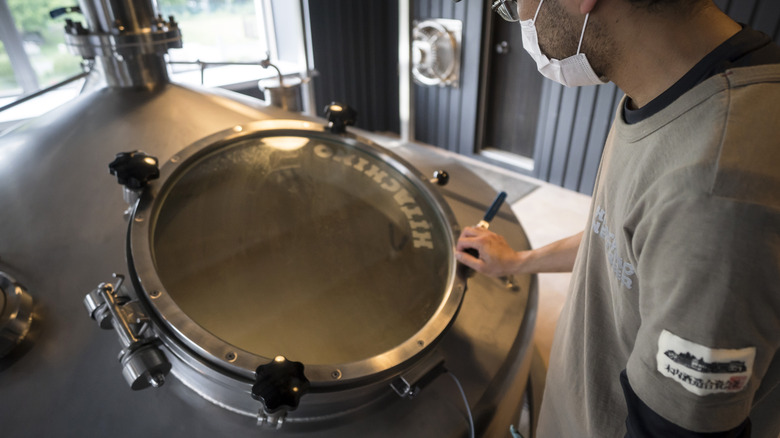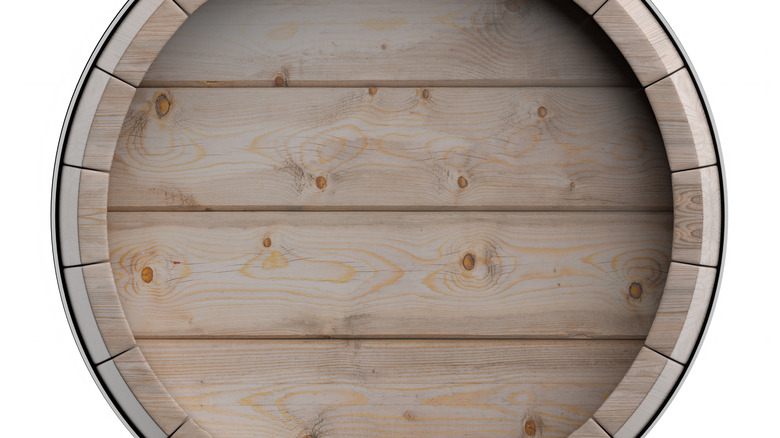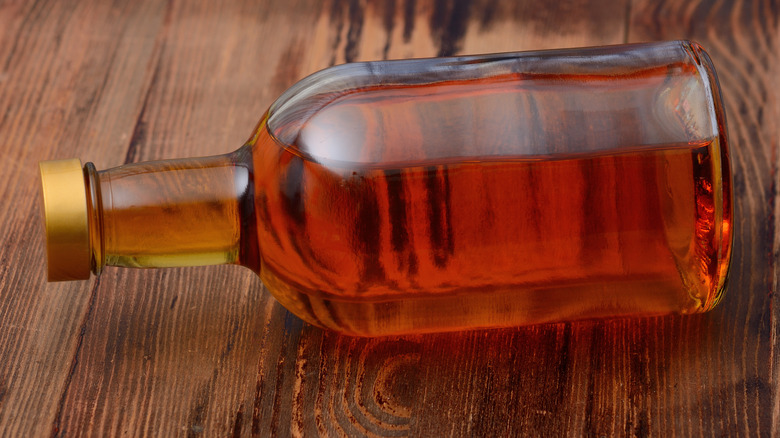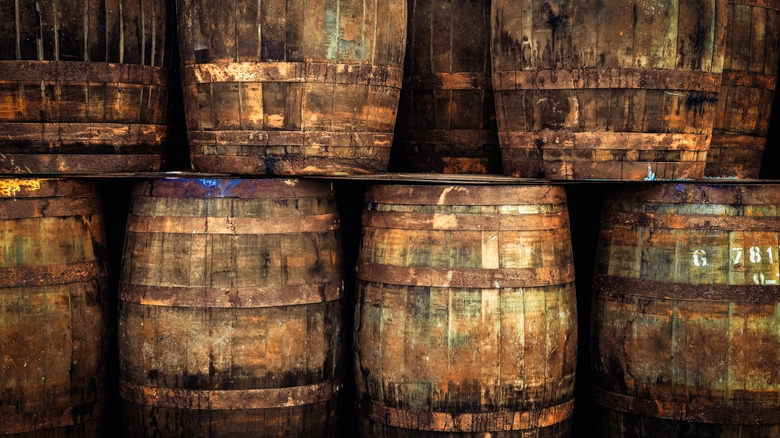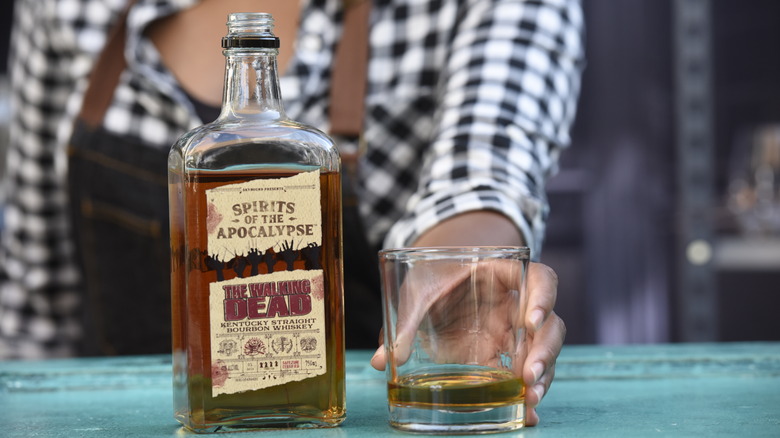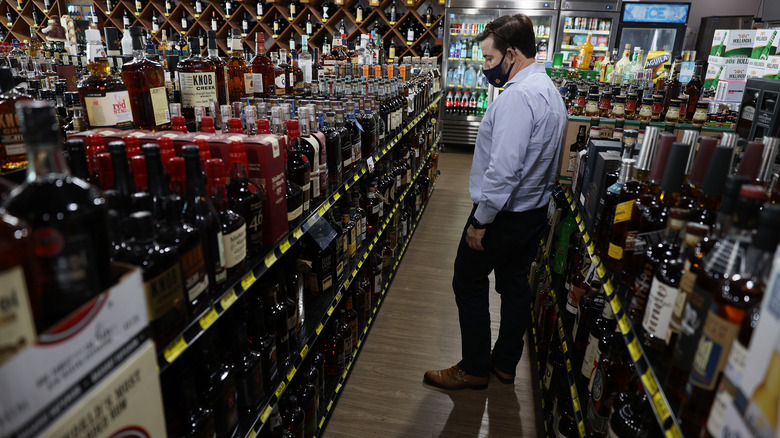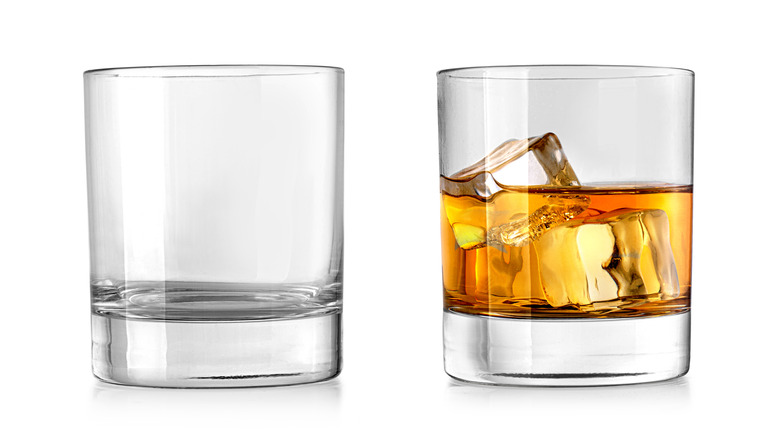35 Important Bourbon Terms, Explained
Bourbon seems so straightforward, and yet it's so incredibly complex from just the littlest changes in a small number of variables. The many terms used to characterize the changes in those outcomes can quickly become just as hyper-nuanced, and it doesn't make understanding this spirit any less baffling when a lot of terms get second use. When you're trying to detect if the finish on your whiskey was finished in rum casks, it's a run-around definition. And while all bourbons have a barrel-entry proof, only barrel-entry-proof bourbons have their original barrel-entry proof.
Don't worry. We'll help you make sense of everything. We've done all the combing through finely printed government PDFs, so the hard part's over. With a little reading, you'll turn the list of bourbon terms to know and understand from exhausting to exhaustive. It might not be quite as satisfying as that pour of bourbon in your hands, but it sure will help you comprehend why that's the case.
1. Bourbon
All bourbon must be made entirely in the United States, have a mash bill of at least 51% corn, and be aged in new, charred oak containers. Only water can be added to the distillate, so no coloring agents are allowed. Bourbon can only be distilled to 160 proof (80% ABV) but must enter the barrel to age at a maximum of 125 proof.
When it comes to bottling, it must be 80 proof or above, meaning the evaporation in the barrel, cutting with water, and blending all come into play. Straight bourbon has additional requirements.
2. ABV
Alcohol By Volume is simply the percentage of bourbon that's booze versus water (and sundry other chemical compounds present as byproducts of distillation and aging in extremely small percentages). The Tax and Trade Bureau (TBB) requires all spirits to label their ABV and permits them to express it as an adjacent proof number, which is double the ABV.
Older conversions from other nations, who no longer measure ethanol in proof, vary. ABV is a more scientific measurement method; most countries have phased out proof statements.
3. Proof
The proof is easy to calculate because the U.S. measures it as simply twice the ABV. It has its roots in a test of alcoholic content that sailors used to do using gunpowder, which is badass. The U.S. is the main preserve of this measurement karma, and it's actually required on bourbon labels. These days, the TTB will teach you how to proof your product with a hydrometer, which is not super cool but does give much better readings.
However, as a verb, proofing refers to both this test and as a synonym for cutting whiskey: the act of adding water to meet government requirements at the barreling and bottling stages.
4. Distillate
The liquid condensed in the still prior to entering barrels for aging. While distillate is technically whiskey when it exits the still — though some agree that definition's only true in the U.S. Everywhere else, it's malt spirit — it's what's often called white dog whiskey, having taken on no color or flavor from the barrel.
Lacking those benefits, white dog is pretty electrifying to the taste. That hasn't stopped numerous distillers, including some big-name ones, from releasing it as a wild ride for the brave.
5. Angel's share
A euphemism for the amount of spirit lost due to evaporation while it ages in the barrels. Since most bourbons evaporate while aging, this means the ABV rises and is often cut with water to replace the angel's share or even to lower it to the blender's preferred levels for the best taste.
The angel's share, in part, is why there's a maximum of 125 on barrel-entry proof, although this number has changed a few times, and by some reports, it was as high as 160 in the aftermath of prohibition.
6. Aging and age statements
Aging refers to the period when the whiskey has been casked and resides in the barrel to enrich and mellow out, interacting with the wood. The Alcohol and Tobacco Tax and Trade Bureau requires age statements for any whiskey bottle aged under four years. After that, they're voluntary declarations on a bottle's label that refer to the minimum amount of time any whiskey in the bottle has aged, although not indicative of the maximum.
Blends can enumerate their component whiskeys' specific ages or default to the youngest spirit used but must err on the side of understatement: no rounding up.
7. Barrel-entry proof
Don't confuse this with the related barrel-proof bourbon. The barrel-entry proof is the number at which distillate enters the cask for aging. Here, proof is a noun, not part of the compound adjective describing the bourbon. So a whiskey might be bottled at, say, 102 proof, having had an entry proof of 112, depending on how much its blenders want to cut it when bottling day comes — or not cut it at all.
Entry proof is mainly of concern to distillers, who can maximize their profit by aging high-proof bourbons in limited barrel space, then cutting them down to desired proofs.
8. Barrel, cask, entry, original proof (and strength or uncut)
Until recently, these were synonyms for describing bottles having the same ABV as the bourbon entering the barrel. As of 2021, the TTB recognized the need to govern these various terms but only went so far as to say barrel proof can be as much as two degrees lower than the proofing assessed for tax (i.e. exiting the barrel).
Meanwhile, "original proof," "original barrel proof," and "entry proof" must be the same ABV as their barrel-entry proof. It doesn't include specific terms like "cask strength" and "uncut," but the former is a synonym, and the latter de facto means no water added.
9. Batch proof
This is a term that only Woodford Reserve uses when it attains its ideal bottling proof by blending several barrels of different ABVs, rather than cutting with water. Not to be confused with barrel or cask proof, which refers to whiskeys at the same proof as entry and exit into the barrel, following recent updates by the TTB.
The main thing the terms have in common is that no water is used to cut their ABV, though batch proof does blend to a preferred proof lower than some of its components.
10. Full proof
Friends, good luck getting a consistent definition of this one. Some will tell you that full proof is a type of barrel proof that's casked and bottled at 125 proof, i.e., the fullest proof legally permissible to bottle bourbon, a la 1792 Full Proof.
But that can't be true because Buffalo Trace recently debuted a Weller Full Proof label at 114, using the term as a perfect synonym for barrel proof. Meanwhile, Bourbon, Whiskey & Rye equates this term to original or entry proof, i.e., the ABV going into the barrel, not coming out. As it stands, the TTB is mum on the matter.
11. High proof or overproof
Without a federal definition, the high proof is relative to the opinions of its distiller, but it is generally agreed to start at 100 proof. (Though California considers it to start at the significantly higher 120.)
By most parlance, high proof and overproof bourbons refer to the same bandwidth, though you may find people who delineate by capping high-proof around 125, reserving the term overproof for the truly high-octane spirits out there. But that tends to be more necessary among rums than bourbons.
12. Bottled-in-bond, bonded, or aged-in-bond
To ensure production standards on bourbons worth drinking, the Bottled-in-Bond Act requires bonded spirits to be distilled in a single season and location. Bonded whiskeys must also be aged four years or longer in wooden containers. (Bourbon must use oak barrels anyway, so no worries there.) Distillers can add nothing except water to reach exactly 100 proof. Additionally, bonded bourbons can't contain other types of whiskey or vice versa, even if they qualify as bonded themselves.
Qualifying whiskeys are inspected by agents of the Bureau of Alcohol, Tobacco & Firearms during storage in bonded warehouses.
13. Charcoal-filtered (the Lincoln County process)
Unlike chill-filtering, charcoal filtration takes place before barreling. Chill-filtering removes fatty acids from the final product for aesthetics at the cost of taste, whereas charcoal filtering is meant to mellow out the distillate prior to barreling to soften in a few days what might otherwise take years, and clear the path for interesting flavor interactions with the oak.
Charcoal is strongly identified with Tennessee Whiskey, but bourbon can do it too. Some bourbon aficionados will tell you that there are multiple interpretations of the phrase charcoal filtration but assume The Lincoln County Process normally.
14. Chill, non, or unfiltered
This is the process of passing cold whiskey through a series of filters (the materials vary greatly) before bottling for visual appeal. Unfiltered whiskeys may appear hazy, particularly when on the rocks or otherwise drank at lower temperatures when their fatty acids clump together. Chill filtration seeks to invoke that phenomenon before bottling so that it can be removed. The result is a visually uniform, smooth liquid that's more appealing to some people and product photography, looking cleaner and purer.
However, a great many drinkers and distillers find non-chill-filtered bourbon to be more satisfying on the tongue, and some labels proudly tout that they are unfiltered to preserve the spirit's complexity.
15. Overoaked
While this one is a matter of opinion that can't be measured. Oversoaking is when the wood comes to dominate a spirit with nutty, earthy, and, well ... wooden flavors. Bourbon is especially susceptible to this since it's required to be aged in new oak barrels, and it's part of why many folks agree a dozen years is about the top of what the whiskey can benefit from in the barrel.
Scotch, which can legally reside in barrels used for bourbon or anything else, often resides much more comfortably in the mellowed oak for 20 years or more.
16. Burn
The stinging sensation of whiskey on your tongue, lips, cheeks, and — if you hold it in your mouth wrong — up your nose. For some, it's a hurdle; for others, it's an attractive feature. But in either case, it does present a challenge to tasting the complexities of a spirit.
Although it's caused by alcohol, a lot of higher-ABV whiskeys minimize it, so there's more going on. A lack of burn is a key component of what gets bourbons described as smooth, in partnership with their texture of level of unctuosity.
17. Finish
The finish is the taste of a spirit as it's swallowed and clears the mouth to detect subtler notes with the burn over and volume removed. It is very often quite different from the initial taste as it hits the tongue, which can be credited to how the aromas interact differently with the sinus.
To maximize its effects, it's recommended to exhale fiercely through your nose as you swallow to dispel the ethyl alcohol fumes and experience the finish properly. This term shouldn't be confused with finished or finishing.
18. Finished, finishing, barrel-finished
After completing the legal requirements, a bourbon (or another spirit) is moved to other barrels for their desirable aspects. In bourbon's case, this is the time spent aging in new, charred oak and possibly other legal obligations depending on the type of whiskey.
Different woods can offer new aspects to a bourbon, as can barrels that have previously housed rum, wine, brandy, etc. Finishing does not replace the required new-oak-barrel aging minimum of two years for straight whiskey or four for bonded. Regular bourbon has no minimum for aging. Not to be confused with the finish of a tasting.
19. Four-grain
This is exactly what it sounds like: a mash bill using four different grains. While you can make a whiskey out of any cereal crop, and some distillers, like Corsair, indeed have tried their hand at mash bills like quinoa and triticale, the bulk of labels sticks to the big four: corn, barley, rye, and wheat.
Oats appear once in a while, too. Beyond that, whether they're bourbon, rye, or something else is just a question of percentages and process. Four-grain whiskeys appear to be having a moment, as more labels either appear to be in production or at least are touting it lately.
20. High-rye
High-rye is another undefined term, legally speaking. It refers to the amount of rye used in the mash bill, but high-rye is such a relative term, depending on who's producing it and what they consider an acceptable alteration of their usual proportions.
The high-rye description generally lives in the realm of 20 to 35%, although you could conceivably go all the way up to 49% and still call it bourbon if the rest is corn and you're foregoing malted barley in favor of the direct addition of enzymes.
21. Wheated
Bourbon using wheat instead of rye in the remaining mash bill: usually about 15 to 20%, although it could be as high as 49% if that's what you're into since U.S. distillers are allowed to skip on the malted barley to use lab-made enzymes. And yes, wheated ryes exist, but they're not much of a phenomenon at the moment.
Wheated bourbons aren't to be confused with wheat whiskey, which must be 51% wheat on the mash bill and, therefore, cannot contain enough corn or rye to qualify as those spirits.
22. Kentucky chew
Kentucky chew refers to the act of swigging the whiskey around your mouth while chewing to taste its complexity. The more movement, the more interaction with your taste buds, as opposed to holding it still and numbing your mouth with the burn.
Activity equals nuance on your tastebuds. You also have to breathe through your nose as you do so to vent the alcohol's fumes. As far as detailed instructions to get it down pat, you'll want to put your nose in the glass, breathe through your mouth, swirl, and smack your lips after swallowing. An adjacent term, the Kentucky Hug, is effectively the aftermath of feelings in your mouth after that sip has left the premises.
23. Nose
The aroma of whiskey will tell you a lot about its profile before you ever put a drop of it on your lips. Nose is commonly used as a verb, or more accurately; the noun might best describe the brief interaction of the spirit and the schnoz.
"To nose" a bourbon means a complete micro-sequence of inhaling, sniffing, wafting the good fumes in, and venting the bad ones away. This is why the purposeful shape of Glencairn glass is such a preferred instrument among whiskey tasters.
24. Neat
When whiskey is served by itself, with no ice, mixers, or a drop of water, that's neat. Also called straight, though not to be confused with the government definition of straight whiskey and straight bourbon as a production method.
If you get confused, remember: Nothing Else Added To, a mnemonic acronym we made up just now and are passing on to you for free. You can thank us for buying us a bourbon at the bar. (Neat, obviously.) That'd be pretty neat of you to do.
25. Malt
Malted grains — mainly barley, but you can malt any cereal — release enzymes that accelerate fermentation while breaking up the formidable proteins in wheat and rye. Grains cycle through soaking and air drying to germinate, then are kiln-dried to arrest enzyme development while roasting the grains to the distillers' preferred level.
U.S. whiskeys, bourbon included, are free to forego malted grains and use enzymes directly, unlike scotch. The American Single Malt Whiskey Commission was formed in 2016 to set out guidelines, and the TTB added a definition to its rulebook this fall, reports Wine & Spirits.
26. Mash
The mash is simply grains (and malt, if we're differentiating) cooked in water heated to optimum temperatures to extract their sugars and combine them with the malt's enzymes. A mash bill is the list of grains used. A sour mash uses a bit of a previous mash batch as a starter seed for fermentation of the new batch, much like you would when making yogurt.
That's it! It's basically a shorter word for "simmered porridge." When the starches are released and broken into sugars, it's time to filter the mash into a wort.
27. Wort
After filtering out the solids from the mash, the sugary liquid is known as the wort. While beer would be boiled at this point to clear the field for yeast, whiskey distillation may jump straight to fermentation and even leave the grain in.
The bio-variety benefits bourbon's flavor since it will be distilled above boiling. Once the wort cools for yeast to survive, it's referred to as the wash: effectively beer, though not a type of beer most people would want to drink. It's then distilled.
28. Single barrel
Finally, a clear-cut term! Single-barrel is just that: a lone barrel that's so exceptional it would be criminal to mix it with anything else. Distillers and drinkers get excited about these because they're either going to be very good, very different, or both.
Typically single-barrel releases will include the barrel filing number. If released in a series or under a label, distillers may share a warehouse location, a specialized mash bill, or another unifying part of the process. But these bourbons can still vary a lot from barrel to neighboring barrel.
29. Reserve
Any barrels a distillery holds back for special use, whether to give the bourbon more time to develop in pursuit of an interesting flavor or simply because it's already so darn good, is called reserve. If it's intended for distillery use (or very limited, even conditional, release), it's often called a private reserve.
It's a common term but not an official one, and you may consider it reasonably equivalent to select. Though because there's always confusion in this terminology, some say select reserve to mean the reserve's reserve, which probably brings us back to the private reserve.
30. Small batch
Very similar to single barrels, small batch bourbons are a blend that's so remarkable it has to be captured and released in its idiosyncrasy. Once the master blender has the combination down, there's no point in losing that something special in dilution among other whiskeys.
It could also be a small batch simply due to key elements not being available: a particular barrel is the last one, or its siblings aren't available for years yet ... the reasons are as varied as what exactly constitutes a small batch. To some distillers, it's a few dozen barrels of the blend. To others, it's hundreds.
31. Straight
While many people order bourbon straight, meaning neat, the TTB is only concerned with your straight bourbon in the production process. That means aged at least two years and still subject to the age statement rule if less than four years. This is an easy rule to satisfy, so most whiskeys are straight, whether the label touts it or not.
Not to be confused with straight up, in which you savages chill your whiskey to mute its glory, then strain it to prevent dilution even though that's the lesser infraction.
32. Flipper
A bottle worth buying for its resale value, or a person who does such speculation. That doesn't mean the whiskey in question is no good: usually quite the opposite, as underrated bourbons became worth trading for their quality and scarcity. However, the spiraling trap of this market is that the more desirable a bourbon becomes to drink, the more it tends to become too valuable to justify drinking.
Collectors have strong opinions about flipping bottles, depending on your views of how good or bad it is for the whiskey market. Still, lots of great bourbons under $50 await you out there.
33. Tater
Say what you will about flippers; at least they know their stuff. A tater is a dilettante who chases the hype. These are the crypto-bros of the spirit world, telling you that you're missing out on an opportunity but cannot explain why you're cheating yourself.
They are hipsters, posers, and pretentious types lacking savoir-faire, and we've all been one at some point unless your last name is Beam, Noe, or Russell. Help them over the hump, and they might flourish. Unless that tater refuses to grow eyes, go easy on them.
34. Glencairn
A small glass with a bulbous shape and no stem, designed to enhance every stage of whiskey tasting. The bulge below a narrow lip allows drinkers to swirl the glass to examine its legs, as well as tilt it for sniffing and experiencing the whiskey's characteristics with minimal obfuscation from ethyl alcohol fumes.
While you could let whiskey breathe for a minute for every year of aging, that could turn into a very long evening. Swirling disperses those fumes more actively. Plus, it has the additional benefit of aerating the whiskey, which will open up its flavors.
35. Old-fashioned or rocks glass
One of the most common glasses for drinking whiskey, this squat type of tumbler is a perfectly cylindrical glass with a heavy base. As the name suggests, it is very well suited, and even designed for bourbon on the rocks, meaning served with ice.
A tumbler fills the hand nicely with a hefty solid base, and its broad mouth makes spills unlikely, particularly since its diameter makes even a two-ounce pour lie relatively shallow.
